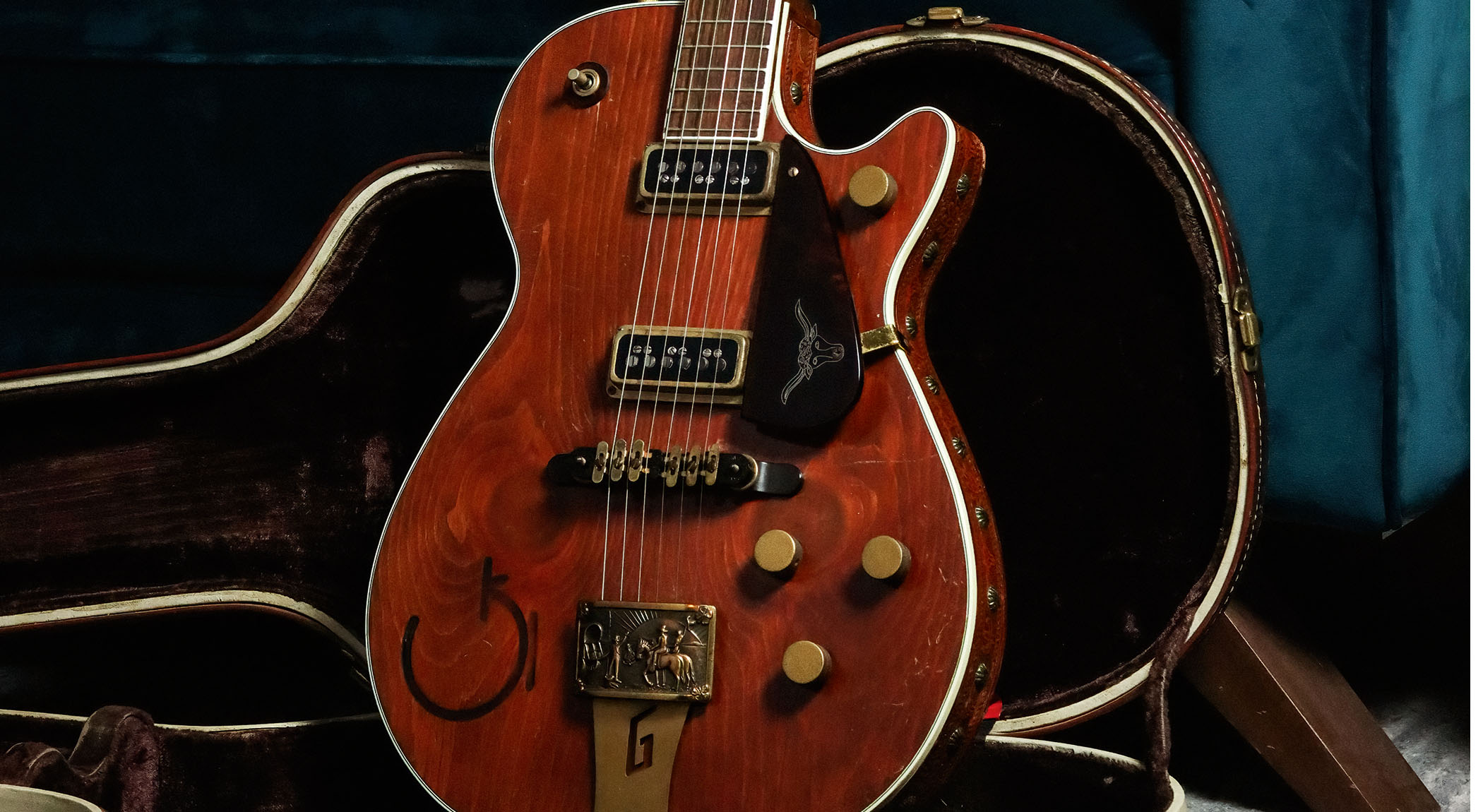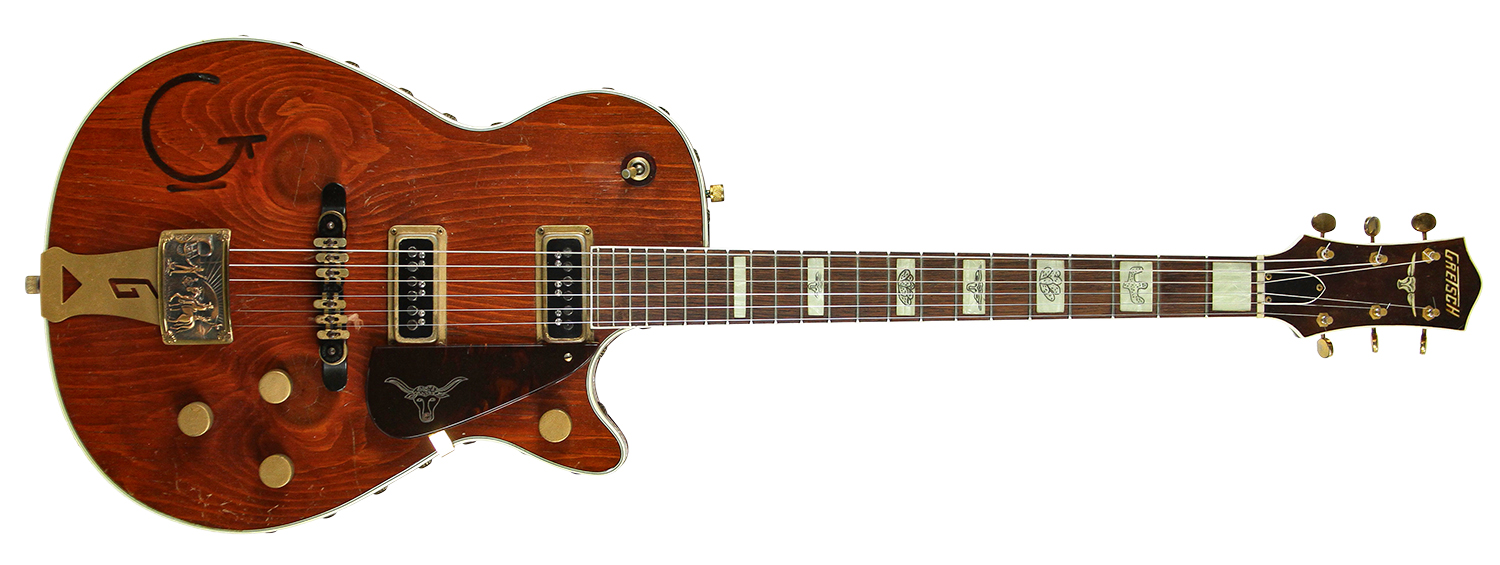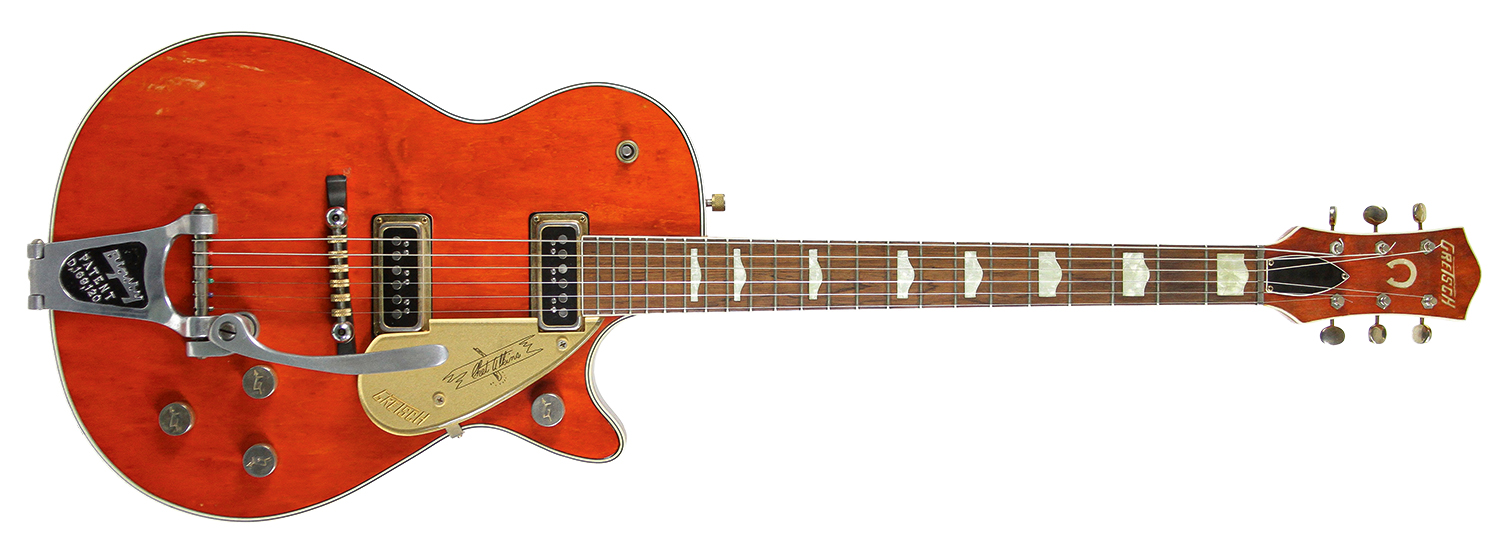
The Gretsch 6130 Round-Up premiered in 1953, but customers didn’t start seeing it until 1954. The Western motif inlay at the 1st fret didn’t appear until 1955, which is the year this one was made.
“The knotty pine top wasn’t something that could be ordered and some of the guitars just came that way while others didn’t, with no explanation from Gretsch,” says Dave Davidson, owner of New York’s Well Strung Guitars. The pine was usually very thin, and if these guitars aren’t packed well and there’s an accident, the control knobs can push right through the top.
“They had every bell and whistle that Gretsch could offer you besides the bejewelled knobs, which were reserved for the Falcon and Penguin. But it has the Western motif inlays, gold hardware and the belt buckle tailpiece with the lasso scene.
“They were originally priced at around $300, which was more than a $182 Stratocaster but less than a Goldtop Les Paul. Gretsch was trying to produce something to compete with Gibson’s Les Paul model but at a price point about $100 lower.
“Round-Ups are a lot lighter than a Les Paul because they’re chambered, but they did that to save money, not to make the guitars light. Gretsch pricing included the case, whereas Gibson charged additionally for their cases.

“Believe it or not, the Round-Up guitars remained in the catalogue until 1960. They weren’t actually pictured after 1955, but Gretsch did state they were still available.
“However, I don’t know of anyone who has ever seen one made later than 1956. In effect, the 6121 was a replacement for the Round-Up and both models tend to produce a very specific sound. Some avid Gretsch players that I know claim to hear a difference between Round-Ups and 6121s with DeArmonds. To my ears, they sound pretty much identical, despite the 6121 having a thicker mahogany top.
“The 6121 has a much brighter colour and it’s what we call ‘Gretsch Orange’ today. All the Western motifs are gone and the steer-head inlay in the headstock changed to a horseshoe inlay. Gretsch also modified the shape of the truss rod cover. 6121s have humpback inlays starting at the 1st fret and Filter’Trons replaced the DeArmond Dynasonic pickups in 1958; my old friend Brian Setzer prefers the Filter’Trons.

“This example has a factory-equipped Bigsby, and in the early days the Bigsbys Gretsch fitted weren’t gold-plated or anodised, even if all the other hardware was gold-plated. The fretboard material was no longer beautiful Brazilian rosewood, and you tend to start seeing Indian rosewood at this time. It’s a much lighter colour compared with the deeper and richer brown of the earlier ones.
“The earlier Melita bridges were replaced by the Space Control bridge, which worked really well with Bigsbys because they rolled as the strings moved. It was pretty ingenious for the time considering it was just a piece of threaded rod. An aluminium nut also replaced the Round-Up’s bone nut.
“The pickguard shape was changed and the steer-head motif became a Chet Atkins signpost logo. Chet had become the ambassador for Gretsch and every model became a Chet Atkins something or other.”

“I don’t aggressively seek out Gretsch guitars for my store and I wouldn’t travel to a trade show just to buy one, but sometimes they come to me.
An older gentleman came into the store and told me, ‘I made that guitar...’ I hadn’t realised the gentleman was actually Fred Gretsch Jr
“The only exceptions would be Falcons and Penguins because they are what they are and many people feel they need to be a staple of their collections. Despite not being a huge Gretsch player myself, they are kind of neat and different. If you’re a collector, something like a 6130 would look good, too.
“In truth, the build quality of vintage Gretsches can be hit and miss. I remember being told by a former Gretsch employee that they would go out and have five-Martini lunches and then try to put guitars together in the afternoon. Another time, many years ago, I had a 1957 6120 hanging on the wall and an older gentleman came into the store and told me, ‘I made that guitar.’
“I didn’t believe him, but he insisted: ‘If you take the pickup out you’ll find my initials FGJ written inside.’ I eventually took the guitar down, looked under the neck pickup and there they were. I hadn’t realised the gentleman was actually Fred Gretsch Jr. Far from being a crazy old man, he was the man himself and I felt like such a fool.”







